

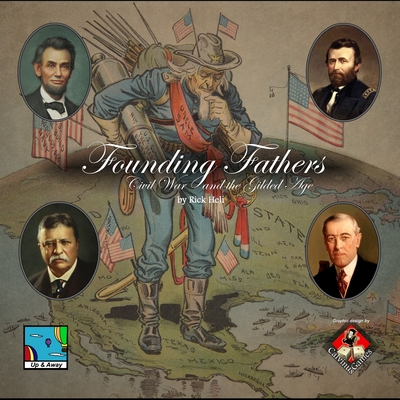
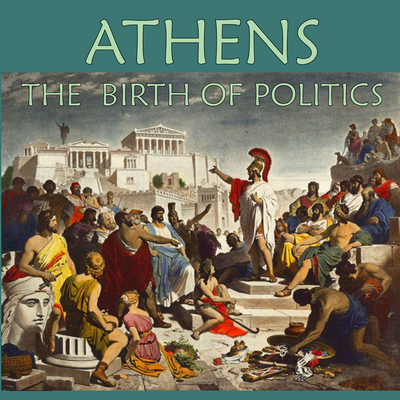

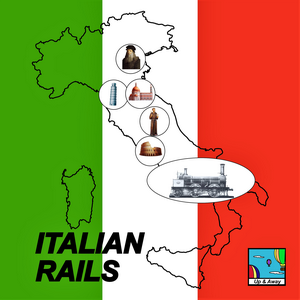


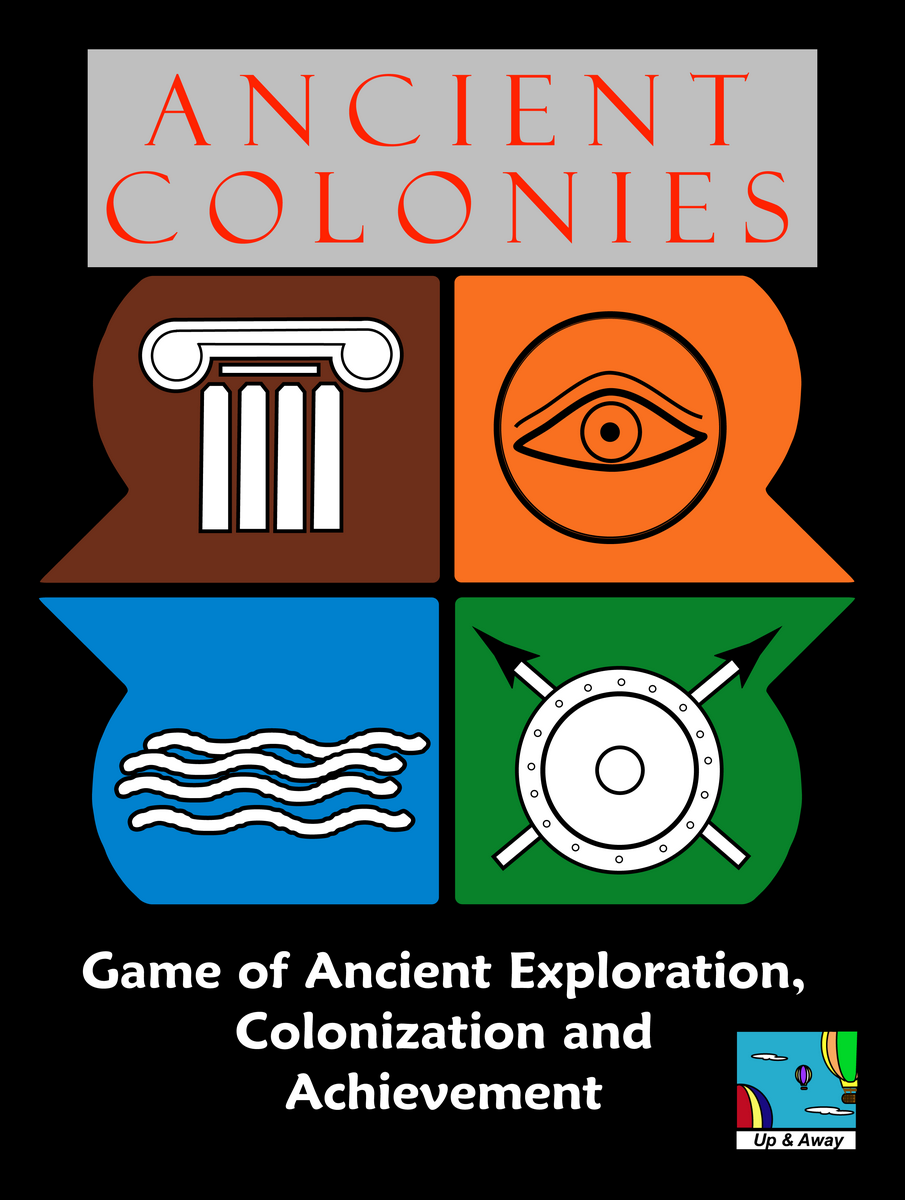


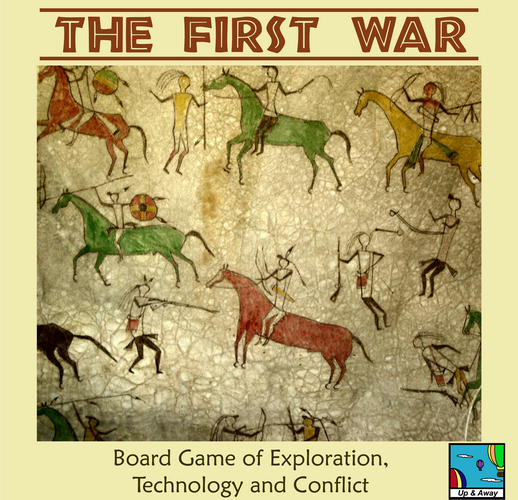












|

|
DESIGNER DIARY
by Rick Heli I thought it might be fun to write something about my game design projects, something I've never tried before. |
March 20, 2021
Well, apologies that it has been super long since last time. There have
been intervening health and other matters, but happily some progress has
occurred and there are developments to talk about.
Admiral Zheng He
Founding Fathers
There are actually three developments for this game.
Imperial Glory
This is an entirely new design that began when a post by Michael Connor on
ConSimWorld asked a good question:
why haven't there been more games using the brilliant
SPI Empires of the Middle Ages system (by Jim Dunnigan and
Anthony Buccini). Michael has been subsequently working
on such a game set in the Japanese feudal system. For me, it inspired a
solution to a problem I had been pondering.
For a long time I've been thinking about how best to represent the First Four Empires period, a term I use for the ancient period 50-220 CE. Remarkably, during that time four great empires ruled Eurasia in a period of relative peace and stability, until it all came crashing down. Then it resumed once again with the Byzantine, Sassanid, Hephthalite and Tang empires, until this too came crashing down. How was it that there always seemed to be either stability or instability in all four spheres? Certainly interesting questions to study and ponder. But where to start?
Reading Michael's question it occurred to me that Empires of the Middle Ages might be a great starting point. As I reviewed it, I found some basic things I wanted to add:
Emperors
In thinking about emperors and their ratings, a problem arose. Instead
of generating random emperors, I wanted to use historical ones with
real names, ratings and images. The randomness comes from the order
in which they appear. But some of the
Roman emperors who today are considered bad were not necessarily
incompetent. It would be more accurate to say that they had different interests.
Nero considered himself first an artiste. Caligula was more interested in
practical jokes. These are just two examples. What could be a good way to
rate such emperors?
Advisors
I decided simple ratings were just not enough. Somehow the design should
reflect their whimsicality. The solution was to add advisor cards for each
emperor. That way, the more an emperor is interested in war (Trajan), the
economy, diplomacy, architecture (Hadrian), art (Nero), philosophy (Aurelius)
or subterfuge (Caligula), the more cards of this type their deck will have.
Each turn then, from your hand of five, you will turn up one, which tends
to be one of his favorites. If the player, as the emperor's consigliere,
doesn't want to perform the corresponding action just now, they can spend
an influence point to draw another card, in effect to see whether they
can change the emperor's mind. It's not only a push-your-luck system,
it also requires evaluation of just how serious the current
situation and how necessary taking a different action really is.
Deck Size
If your action succeeds, you get to add an advisor to your deck, but
if you fail, you lose the advisor(s) you used. In addition, when you
conquer an area you add the corresponding province card to your deck.
You can also use the subterfuge action to remove an advisor.
In these ways you have some control over the size of your deck.
At times you may prefer a fat deck to have more options and
keep costs lower – when
your deck exhausts you must pay to maintain your armies – but on
the other hand a thin deck brings back your best advisors
and generates trade income more quickly.
Influence
On top of this, the player needs to succeed in whatever action they choose
if they want to keep their spent influence points. Failing, or spending
too much, will limit your ability to convince the emperor to your way of
thinking in the future. More influence appears when the emperor dies, the
amount depending on his popularity at that time. So if you did well by the
previous emperor, the new one will pay more attention to you.
Armies
The original game didn't feature armies. Instead, combat is essentially
a comparison between the economic level of the origin province with that
of the target, plus leadership and money. One way to make this more
interesting is to place actual armies on the map, but then, how should
they fight? This was the biggest stumbling block in the design. Such a
subsystem could become extremely detailed. After all, there are entire
games whose raison d'être is an ancient battle.
But it was important that it not become too
long or involved lest it overshadow the rest of the game. On the other
hand, it could be very simple, perhaps simply comparing the number of
armies and their types and maybe adding some cards and dice to reach a
resolution. But this would run the risk of being so abstract as to be
dissatisfying.
Combat
So what to do? After a lot of pondering and going back and forth between
various ideas, I happened upon a schematic chart to study ancient combat that
I made a long time ago. It depicts relationships between various types of
ancient units, the same kinds of units featured in this game. Could this
chart somehow serve as a basis for a combat system?
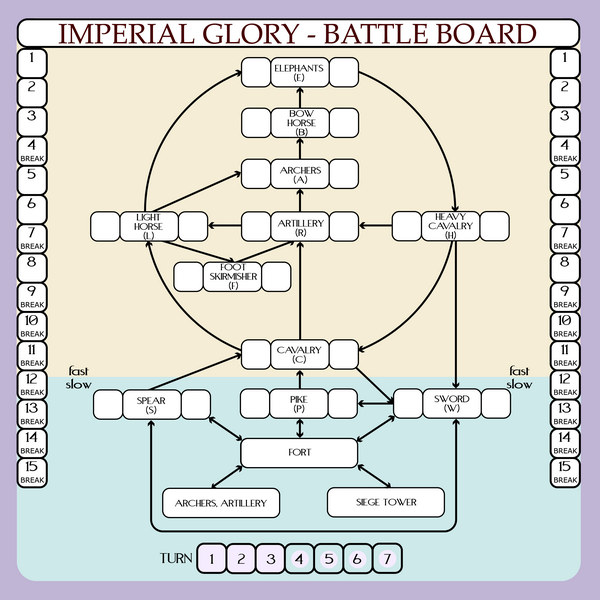
Terrain
In the original game all provinces were generic, but now that we were
venturing outside Europe it seemed important to represent variety in this
area. In particular, the Kushan forces were primarily horse archers. While
this was a very powerful type of unit, it definitely had limitations in
the forests and deserts. I not only assigned each province a terrain type,
I also assigned types to the connections between provinces to reflect
mountain passes that hinder movement.
Trade
Trade is often difficult to represent well when the players represent
governments. Governments can encourage or inhibit traders, but fundamentally
trade is an activity that occurs independent of their activities. Thus,
it's better for trade to operate autonomously within a governmental system
rather than let the players make its decisions. Given that, the problem was
how to represent it usefully without going into too much detail. At length
I decided that since players already had decks that they traverse,
these could
be good venues for the periodic arrival of trade. Each empire has a trade
card that, when drawn, they pass to the discard pile of the
next player on the route. Then when the next player draws it out of their
deck, they receive the trade income and pass it to the next player.
Fighting the System
One of the most fun aspects of the original game is that you spend a lot
of time fighting the game system, in some scenarios more so than the other
players. I wanted to keep this concept, but avoid all the special tables
and phases that the original has. Instead, I decided to funnel all this
type of activity into a single phase, the draw of the Fate card, which can
trigger all kinds of civil wars, coups, heresies and many more. I placed
this at the end of the turn so that this surprise would take effect at
the end of the player turn. While the others are taking their turns,
the affected player can be thinking about how best to handle the new
situation, which should help keep the game moving.
Large Empire vs. Small Empire
Conceptually, a small empire should be easier to manage than a large one,
and this game certainly features wide disparities in this regard. The Kushans
begin with a single province while the Romans have almost everything we think
of when we remember the empire (not Dacia and some provinces in the east).
To model the management problem, I put the provinces on cards that live in
the player's deck. Their appearance means that their tax payments
have arrived, as well as any recruits you request of them. The third
connection, though, is with the Fate card disasters, many of which can
only affect a province in the current hand. Thus, at the start the Romans
will have a lot more places to worry about and problems to fix than the
Kushans will, even if they are receiving more income.
Results
The original game used cards to determine a result for all endeavors and
I decided to honor that, even though I could have used dice instead (and
you can still can, if you really prefer that). Originally I used result
cards, like the original, but over time it seemed the extra calamities
and benefits that these cards could provide, were too noisy. The player
is so interested in the main result that side effects are too distracting.
It turned out that people were even forgetting to implement them. I found
it better to keep such events to the Fate cards. Removing the extra effect
texts meant that the cards could become counters instead, which has advantages:
(1) it's easier to draw from a cup than to shuffle cards, (2) laying out drawn
counters takes less space. But why this and not dice? Because once some chits
are out, you have a greater idea of the likelihood of success, though not
perfectly, because the last five counters are hidden and not used. In the
ancient world they believed in taking the auspices; in this game, checking
out the counter history is the equivalent.
Pandemic
Once Trade was working, the pandemic, which moved around Eurasia via trade,
was easy to figure out. It could arise as a Fate card and
travel from player to player in just the
same way, followed by an immunity card, which would slowly end the pandemic
effects around the board.
Winning
In the original game the player with the best developed, claimed,
colonized and converted wins. This design, because of the period,
doesn't have claims, colonization or conversion, but there was
a lot of art, architecture and science. Consequently, these are
additional factors that can contribute to victory, and also permit
varying approaches to play.
Staging
Altogether this is a large game, a three-mapper stretching from Spain
to Shanghai, with lots of bits and cards. So, it seems best to just
start with one map with most of the basic stuff and add expansions
later, being mainly cards and army counters. Deciding which empires to
present was an interesting decision. The Romans and Parthians are the
most familiar. Han Dynasty China has the biggest challenge from
"barbarians". But the Kushans have a very challenging growth curve,
starting with a single province and wanting to grow in several
directions. Which order and directions to go make for such a good decision
space that you don't even miss that there are no other players. Plus,
the Kushans are probably the least familiar of the empires so there's
a chance to learn something new as well.
